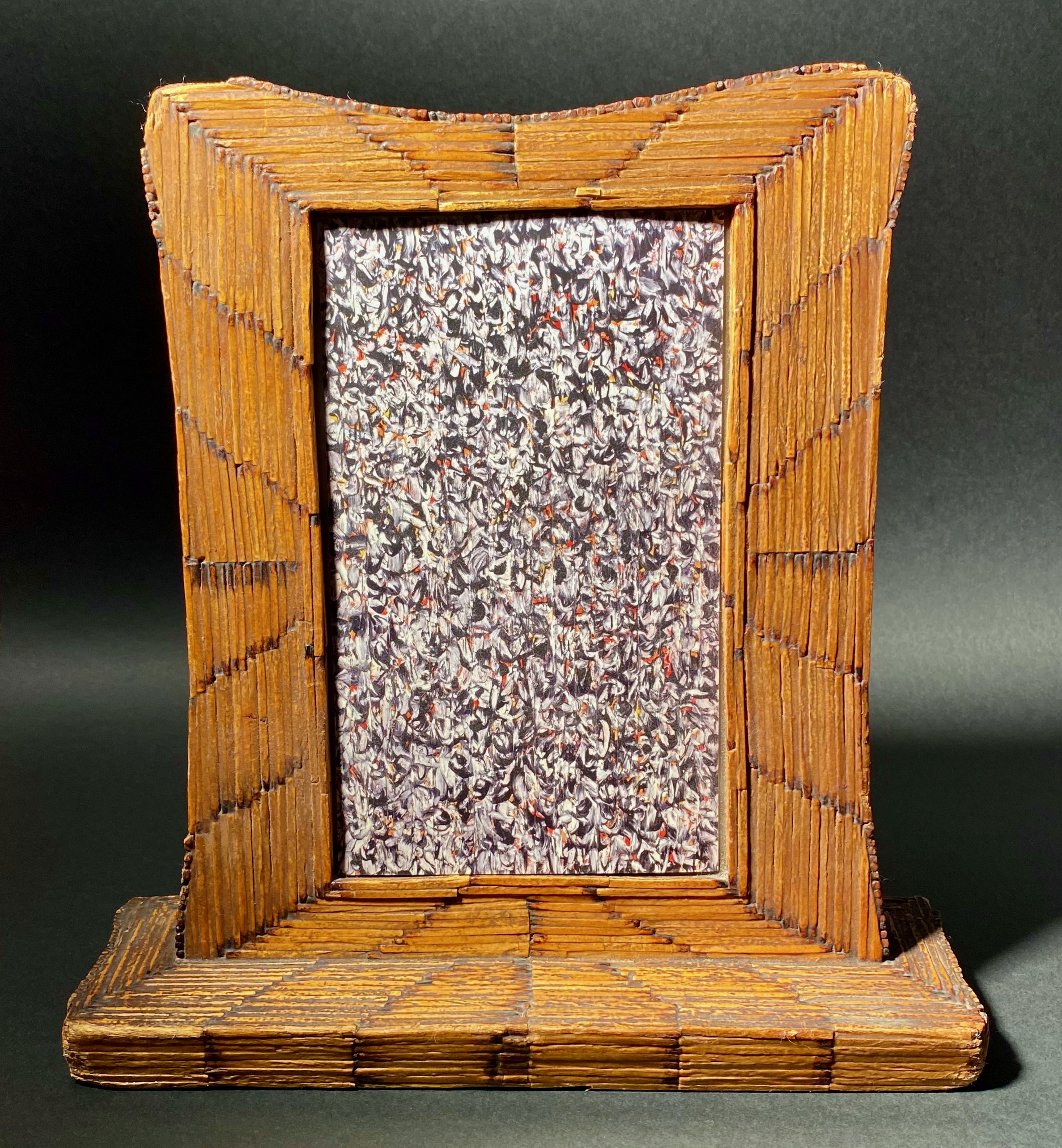

Title: Antique Turn-of-the-century Arts and Crafts Wood Match Frame
Shipping: $29.00
Artist: N/A
Period: 20th Century
History: Art
Origin: North America > United States
Condition: Good
Item Date: N/A
Item ID: 542
Early 20th-century handcrafted display Frame. A wonderfully beautiful texture tramp art antique turn-of-the-century Arts and Crafts handmade wood match pitcher frame. During the late 19th and early 20th century, the Arts and Crafts movement ushered in a transformative approach to craftsmanship and design. This period marked a departure from mass-produced, machine-made goods, emphasizing instead the beauty and integrity of handmade items. In the realm of frames, artisans began to explore the use of ordinary materials to create unique and artistic pieces. Wood, in particular, became a favored medium due to its versatility and accessibility. Craftsmen sought to celebrate the natural qualities of the materials, often eschewing elaborate ornamentation for a more rustic and authentic aesthetic. Frames crafted during this era were characterized by simplicity, functionality, and a connection to nature. Artisans drew inspiration from traditional craft techniques, incorporating hand-carving, joinery, and other manual skills. The goal was to produce objects that reflected the value of human labor and skill, in contrast to the uniformity of mass-produced items. Common materials included oak, cherry, and other native woods, chosen for their durability and inherent beauty. The frames often featured subtle details, such as hand-carved motifs or inlays, showcasing the artisan's dedication to the craft. The Arts and Crafts movement sought to revive the connection between the maker and the object, emphasizing quality over quantity. This era laid the foundation for a renewed appreciation of craftsmanship and the use of ordinary materials in artistic expression. The Arts and Crafts philosophy had a lasting impact on design principles, influencing subsequent movements and continuing to inspire contemporary artisans who value the authenticity and individuality of handmade creations.
Primitive arts and crafts objects are highly collectible today for several compelling reasons: Historical Significance: Primitive art often reflects the cultural and historical context in which it was created. Collectors are drawn to these objects as tangible links to the past, offering insights into the lifestyles, beliefs, and traditions of earlier societies. Authenticity and Craftsmanship: Primitive art is celebrated for its authenticity and the direct involvement of the maker. Many pieces are handmade using traditional techniques, showcasing the craftsmanship and skill of artisans. In a world saturated with mass-produced items, collectors appreciate the uniqueness and individuality of primitive objects. Artistic Expression: Primitive art is known for its raw, unrefined aesthetic. It often conveys a sense of immediacy and emotional depth, providing a stark contrast to more polished and formal art forms. Collectors are drawn to the expressive qualities of primitive art, valuing the genuine and unfiltered nature of the creations. Cultural Diversity: Primitive art encompasses a wide range of cultures and regions, each contributing unique styles and motifs. Collectors may be attracted to the diversity of forms, materials, and techniques employed by different communities. This diversity adds richness to collections and allows for a deeper exploration of global artistic traditions. Limited Supply: Many primitive art objects are rare and irreplaceable. As time passes, these items may become scarcer due to factors such as degradation, loss, or increased demand. The limited supply contributes to their collectible nature, driving enthusiasts to seek out and preserve these pieces. Investment Potential: Some collectors view primitive art as an investment, anticipating that the rarity and cultural significance of these objects will increase their value over time. As awareness and appreciation for primitive art grow, the market for such pieces can become more competitive, further enhancing their collectibility. Connection to Nature and Spirituality: Primitive art often draws inspiration from nature and spirituality. The use of natural materials and themes related to the natural world can resonate with collectors who appreciate the connection between art and the broader environment. The spiritual or ritualistic aspects of certain primitive objects also add layers of meaning and intrigue. In summary, the collectibility of primitive arts and crafts objects is driven by a combination of historical value, craftsmanship, artistic expression, cultural diversity, scarcity, and the unique stories they tell about human creativity and ingenuity across different eras and societies.